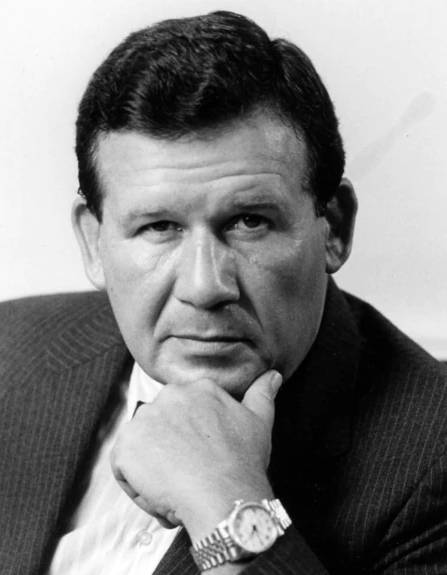
| Net Worth | $50 million |
| Wife/ Died | Lisa McNear Vaughan |
Richard Warner Carlson Bio
Richard Warner Carlson born Richard Boyntonon and famous as Dick Carlson is an American journalist, diplomat and lobbyist. During the final six years of the Cold War, he oversaw Voice of America as its director. In addition to leading Radio Marti broadcasts to Cuba, he oversaw the USIA Documentary Film Service and the U.S. Information Agency at the same time.
In addition, Carlson has written for magazines, worked as a TV and radio correspondent, produced documentaries and reported for newspapers and wire services. Tucker Carlson, a conservative political commentator, is his son.
Where is Richard Warner Carlson now?
Richard today, Carlson is retired as of 2022 and working on a new book. He does not hold any public office.
Richard Warner Carlson Wife
Richard Warner was married to Lisa McNear Vaughan formerly Lombardi aka Carlson. She was an American artist widely known for being Tucker Carlson’s mother.
Lisa McNear Age at Death
At the time of her death, McNear was 66 years old. She was born in San Francisco, California, on June 4, 1945, in the United States.
Richard Warner Carlson Net Worth 2025
Richard Warner Carlson is estimated to have a net worth of $50 million. His versatility across the range of industries he has worked in has contributed to the accumulation of his net worth. His primary sources of income are book sales, government appointments, executive roles and his journalism career.
Richard Warner Carlson Age
Richard Warner was born on February 10, 1941 in Boston, Massachusetts, U.S. As of 2025 he is 84 years old.
Richard Warner Carlson Parents
Richard Boynton, a college student, was born into a family of 18 and 15-year-olds, respectively, Dorothy Anderson and Richard Boynton. Having starved herself to conceal the pregnancy, Richard had mildly bent legs and rickets at birth.
When Dorothy refused to go along with him to steal their child and marry him in 1943, citing that she was only a junior in high school and that only her parents knew about the child, Richard Boynton shot and killed himself two blocks away from her home.
Richard Warner Carlson Early Life
Richard was placed in The Home for Little Wanderers, a Boston orphanage, six weeks after his birth. The residence published a wanted poster about him in the neighborhood newspapers with the headline, “Home Wanted for Foundling.” The only person to reply was Malden housewife Florence Moberger.
After Florence Moberger and her husband Carl were unable to conceive, they were left with three children. He would be fostered by Carl and Florence until a family expressed interest in adopting him. After more than two years of residence, he claimed to have forged a close relationship with the Mobergers.
He said that many potential parents, including Anderson, his birth mother, who was dressing up as her own sister, paid him visits during that time. He was taken in by the Carlson family, a wool broker and his wife, in 1943. At the age of twelve, his adoptive father passed away.
Richard Warner Carlson Education
After completing the Naval Academy Preparatory School, Richard enrolled in the ROTC program at the University of Mississippi and worked odd jobs during his breaks. 1962 saw his discharge and he never finished school. Later, he relocated to Los Angeles.
Richard Warner Carlson Career
As an independent journalist
At the age of 22, Carlson was hired by night city editor Glenn Binford of the Los Angeles Times as a “copy boy.” There, he made friends with Carl Lance Brisson, the actor Rosalind Russell’s son.
In 1963, Carlson started working as a reporter for United Press International. On his two days off, he wrote in Louella Parsons’s Beverly Hills office as a movie columnist for Hearst. Along with working under the editorship of Henry Gris, the first president of the Hollywood Foreign Press Association, he also contributed fan magazine stories to UPI’s Foreign Film Bureau.
Two years later, Carlson and Brisson relocated to San Francisco in an effort to establish themselves as independent, freelance television reporters and produce news features for both regional and national audiences. Until they were hired full-time by San Francisco’s KGO-TV, they were paid less than $100 per week.
The most well-known piece by Carlson and Brisson is from Look that connected Mayor Joseph Alioto to organized crime. Alioto proceeded to file a $12 million libel lawsuit against the magazine. A federal judge determined that the article was “false and defamatory” and that it was “made with actual malice and disregard for the truth.” Due to legal issues, Carlson and Brisson were not listed as defendants in the trial.
The judge granted Alioto $350,000, and Look’s demise was exacerbated by the cost of the legal representation. Carlson defended the report, saying that it was the reason behind the deaths of several of their sources or their refusal to testify.
As an investigative journalist
In 1971, Carlson was employed by Los Angeles’ KABC-TV. Along with producer Pete Noyes, Carlson took home multiple honors, including a Peabody Award for their exposé on car promotion fraud.
Noyes asked Carlson to work with him when he accepted a job in 1975 as an investigative reporter and news anchor at San Diego’s KFMB-TV. But after just 18 months, Carlson quit, calling the work a “kid’s game” that was “insipid, sophomoric, and superficial” and laced with “a lot of arrogance and hypocrisy.” Citing a piece he wrote in which a local tennis player, Dr. Renée Richards, came out as transgender, he acknowledged being a part of the hypocrisy.
Carlson with President Gerald Ford on June 4, 1976
In addition, Carlson attacked G. Elizabeth Carmichael, disclosing her gender identity and refusing to address her as a woman despite orders from the trial’s judge to do so. This tale gained popularity thanks to the HBO miniseries The Lady and the Dale.
“There are so many other things I think are important and interesting but the media can be counted on to do handstands over that kind of scandal and sexual sensation.”
As a Banker
Carlson was appointed director of public affairs for San Diego Federal Savings and Loan, which subsequently changed its name to Great American First Savings. Gordon Luce, a close friend of Ronald Reagan and former cabinet member, was in charge of the savings and loan. In just three years, he went from entry level to vice president of finance.
Great American First Savings was the subject of controversy because of the bank’s political connections. For instance, the bank faced criticism in 1984 for permitting Edwin Meese, an adviser to Ronald Reagan, to fall fifteen months behind on his mortgage.
In the same year, bank officers were charged with accepting federal jobs in return for their pro-Meese stance. Luce claimed that the loans to Meese were a “natural evolution” of combining friendship, politics, and business.
In 1981, Carlson was interviewed by Mike Wallace of the investigative television program 60 Minutes regarding the bank’s contentious home foreclosures, in which the bank was charged with defrauding low-income Californians. Carlson hired a camera crew to record the interview during a commercial break when the 60 Minutes cameras weren’t running. He was able to capture Wallace making a racist joke about Black people and Hispanic people: After Wallace was made to apologize, Carlson left Great American early in 1983 to pursue a career in politics.
As Ambassador to Seychelles
Carlson left Voice of America in June 1991 after President George H. W. Bush appointed him as the United States’ ambassador to the Seychelles.
As a CEO
In March 1992, Carlson was appointed CEO of the Corporation for Public Broadcasting (CPB), a public broadcasting production and distribution company that is a “private corporation funded by the American people.”
The Republican Party officially changed its stance on public broadcasting during his presidency when they added a platform plank denouncing it as “misguided,” “ridiculous,” and unworthy of government support. The official party line was that the system should be privatized because “the party looked forward to it,” and that the public media was liberally biased.
Critics claim that Republicans have weaponized public broadcasting to use it as a campaign issue against candidates who endorse it. Carlson disagreed with the change in platform: “The Republicans are misinformed. They are putting the blame on the wrong outfit.”
As an author
Snatching Hillary, A Satirical Novel (Tulip Hill Publishing, 2014, ISBN 0692337008) was written in collaboration with Bill Cowan and Carlson.
Some of his publications include Women in San Diego’s History (1977), Free and Fair: The Final Two Weeks of Apartheid (1995), and Why Dogs Talk on Christmas Eve (2014).
He contributes a weekly newspaper column for the Charleston Mercury and the Pittsburgh Tribune-Review, frequently discussing national security and terrorism. In Washington, D.C., he used to write political gossip columns for The Hill newspaper. There, he collaborated with Bill Regardie on the book “The Shadow Knows.”



